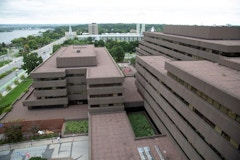
699 results
-

-

-

-

Episode 20: Embodied Carbon
- Podcast by Helen Sanders, General Manager, Technoform North America | FTI President · Irene Martin, Americas West Facades Leader / Associate · Andrea Zani, Project Manager and Engineer · Sophie Pennetier, Associate Director - Special Projects
-

Focus on carbon: Unlocking embodied carbon reductions in facade systems
- Article by FTI Embodied Carbon Working Group
-

Embodied Carbon
- Article by Helen Sanders
Welcome to this edition of the SKINS newsletter, which is all about carbon! As guest editor this month, I am representing FTI’s embodied carbon (EC) working group. This issue highlights several important topics relative to embodied and the trade-offs with operational carbon.
-

-
-
Design of Facade and Overhead All-Glass Structures in Building Renovations
- Paper by Alfonso E. Lopez, P.E. · David Dunham, P.E. · Andrew Duncan
The contemporary renovation of historic buildings often includes all-glass structures that allow architects to preserve the original building design
-
Cities under Climate Threat - Philadelphia, Rome and Venice
- Paper by Edgar Stach, Dr., Ing, AIA/IA · Shreya Kanther · Alexis Manfre
The impacts of climate change, driven by increasing extreme temperature, sea-level rise, and heavy precipitations, interact and play an essential
-
The Great Spandrel Glass Debate
- Paper by Richard Green SE PE P.Eng CPEng IntPE APEC Engineer M.ASCE M.IEAust, Principal / Owner
<p>As we change the rules of thermal performance for facades, we are changing the conditions the glass is subject to in shadow boxes and glazed…
-
Balustrade Design Loads
- Paper by Richard Green, SE, PE, P.Eng, CPEng, IntPE, APEC Engineer, M.ASCE M.IEAust · Andrew Crosby PEng · Terrence McDonnell
A review of balustrade practices from around the world, and why practices in United States and countries using ICC code/ASCE 7 designs are failing to
-
Glass in GSA Buildings
- Paper by Georgia Scalfano, Technical Services Sustainability Manager
<p>Embodied carbon in buildings is a key factor in building decarbonization and while it is generally small compared to operational carbon, the…
-
Consistency In Glass Design
- Paper by Joshua Schultz, PhD, PE, LEED AP, Associate Professor Grace Dojan, Graduate Student
<p>Glass structural elements have become increasingly common to the point of ubiquity; however, there currently is no universally recognized and…
-
A Structural Glass Design Manual
- Paper by Richard Green PE SE P.Eng CPEng IntPE(Aust) APEC Engineer, Principal / Owner Terrence McDonnell S.E., P.E., P.Eng., SECB, Principal Andrew Crosby BASc, P.Eng., LEED® AP BD+C, Principal
<p>Other than limited special cases, there is a lack of standards providing guidance on the design of structural glass. This has resulted in an…
-
Glass Balustrade Design
- Paper by Richard Green, PE, SE, P.Eng, CPEng IntPE(Aust), APEC Engineer · Andrew Crosby, PEng · Terrence McDonnell S.E., P.E., P.Eng., SECB
Glass handrail design in the United States lags behind best practice in other parts of the world. There can be as much as a factor of four (4)
-
The Scope of the Structural Glass Design Manual
- Paper by Richard Green SE PE P.Eng CPEng, Principal / Owner Andrew Crosby P.Eng LEED® AP BD+C, Principal Terrence McDonnell SE SECB PE P.Eng, Principal
<p>The technology of glass now allows glass to be fabricated in sizes and structural configurations not previously conceivable. The standards and…
-
The Vertical Campus Facade
- Paper by Mayine Yu, AIA, Principal | Davis Brody Bond / Page Cooper Schilling, AIA, LEED AP BD+C, Principal | KieranTimberlake Jessica Young, RA, Principal
<p>Case study of the recently opened John A. Paulson Center for New York University in Manhattan reviews design solutions of façade depth and scale…